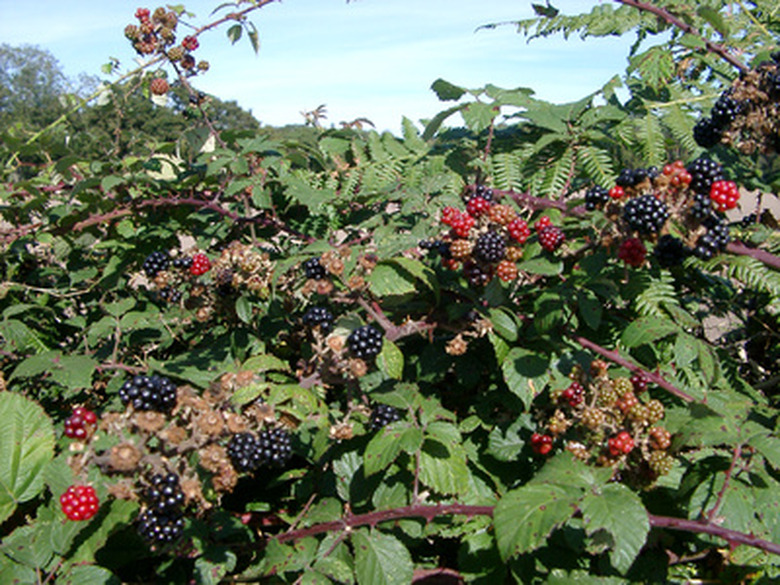Pest & Disease Identification On Blackberry Plants
Blackberries (rubus) are called "brambles" for good reason: Their canes grow in thorny jumbles. Home gardeners grow trailing blackberries on trellises or bushy upright varieties all over the country, but most commercial blackberries grow in the Pacific Northwest where the climate suits them best. Each berry is actually an "aggregate" of smaller fruits called "drupelets," each containing a seed. Several fungus diseases and pests affect blackberries.
Culture
Good cultural care of plants is key to avoiding pests and diseases. The University of Iowa Extension Service suggests planting blackberries in well-drained sandy loam with an acidic pH of 6.0 to 6.7. Each blackberry cane grows for one year and produces fruit the next year. Prune two-year-old "floricanes" that are diseased, damaged or crowded, leaving only four to six canes to bear fruit that year. Pinch back new "primocanes" as they emerge to promote branching. After harvest, prune out floricanes to the ground; destroy them to prevent decay and fungus growth.
- Blackberries (rubus) are called "brambles" for good reason: Their canes grow in thorny jumbles.
- After harvest, prune out floricanes to the ground; destroy them to prevent decay and fungus growth.
Fungus Diseases
The University of Florida lists several fungus diseases for blackberries. Leaf spot, in which red spots form on leaves and weaken the plants, is a common condition. Orange rust starts as bright spots on the undersides of leaves in spring. Crown gall, like verticillium wilt, is soil-borne; it creates tumors on the crown of the plant. Anthracnose appears as purple spots on canes, which will turn gray in the center then darken, turn brittle and die. Double blossom creates abnormal flowering and multiple shoots on primocanes.
Viruses
Most rusts and viruses slow plant growth; they cause a loss of plant vigor and decreased flowering in primocanes. Blackberry calico virus causes faint yellow blotches. Honeybees carry raspberry bushy dwarf virus, which causes a bright yellowing of primocanes in summer. Raspberry bushy dwarf and tobacco streak virus require chemical tests for proper diagnosis.
- The University of Florida lists several fungus diseases for blackberries.
- Honeybees carry raspberry bushy dwarf virus, which causes a bright yellowing of primocanes in summer.
Insects
The University of Arkansas examines a number of insects that affect blackberries. Aphids, leafrollers and thrips may rise in clouds from plants and leave shrunken and deformed leaves in their wakes. The rednecked cane borer creates galls, splits in bark and holes in leaves on primocanes in April through June. Blackberry psyllids attack terminal leaves on the outside of the bramble as flower buds swell. Strawberry clippers or strawberry bud clippers eat around the base of flower buds. Deformed fruit and poor drupelet development indicate the presence of stink bugs or blackberry midges. The green June beetle and Japanese beetle both eat leaves and developing fruit in June; by July, they eat only ripe fruit. The raspberry crown borer attacks the roots in the crown of the plant; canes wilt and the tops bend over in a "shepherd's crook" shape.
- The University of Arkansas examines a number of insects that affect blackberries.
- The raspberry crown borer attacks the roots in the crown of the plant; canes wilt and the tops bend over in a "shepherd's crook" shape.
Considerations
Sometimes prevention is the best cure; healthy brambles are less likely to be affected by pests and disease. Give blackberries plenty of space (and air) to keep foliage in the sunshine. Harvest fruit promptly as it ripens to discourage birds that carry fungi and insects from plant to plant. Plant blackberries away from pine trees where blackberry psyllids spend the winter. The University of Georgia Extension recommends waiting at least five years to plant blackberries in ground where tomatoes, potatoes, peppers or eggplant have grown, as these "solanaceous crops" all carry verticillium wilt.
